|
KEY TAKEAWAYS
|
The challenge
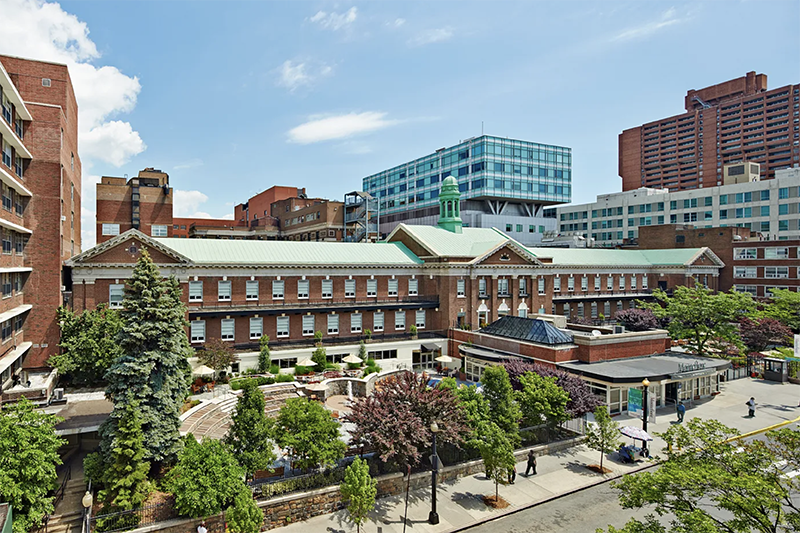
Montefiore is a premier academic health system and the university hospital for Albert Einstein College of Medicine, serving the 3.1 million people living in the New York City region and the Hudson Valley. Its primary area of service is the Bronx, the northernmost of the five boroughs. Over 85% of its discharged patients hail from this borough and it is within this geographic area that Montefiore has distributed the vast majority of its community-based primary care and specialty ambulatory services. The Montefiore Health System is comprised of 11 hospitals, three of which are located in the Bronx.
The Bronx is home to nearly 1.5 million people. According to the New York City Food Bank, the Bronx is also the most food insecure of the five boroughs with nearly one in five residents facing hunger on a daily basis. Nearly half of the residents live below the poverty line.
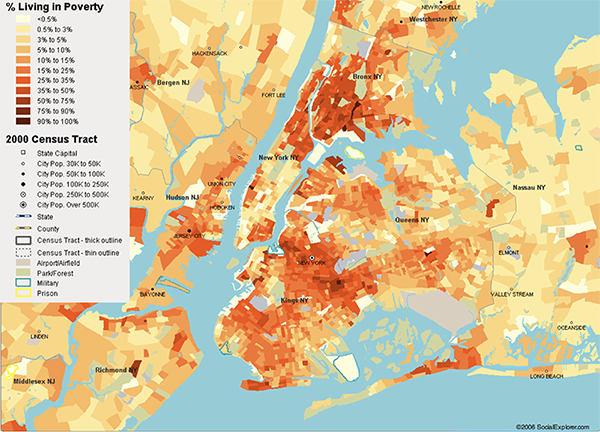
With these economic disparities come related health inequities. The county has the lowest ranking health status in New York State (62 out of 62), as reported in the 2013 County Health Rankings from the Robert Wood Johnson Foundation. This area has one of the largest obesity rates and has been an epicenter of the asthma, HIV, and drug epidemics. The population faces excess mortality rates from heart disease, stroke, and diabetes compared to city-wide and national averages.
In 2009 Montefiore updated its strategic plan and changed its mission to read:
“To heal, to teach, to discover and to advance the health of the communities we serve.”
Community service had always been a part of Montefiore’s mission but this update to its mission made it explicit. From 2009 and forward, Montefiore intended to focus on making a measurable difference in the health of their population and communities. This is further sharpened by one of their five strategic goals: the imperative, to “maximize the impact of our community service.”
From a plant-based vegan diet that is helping cardiac patients get and stay healthy to working with bodegas to increase the prevalence of vegetables in the borough, Montefiore is redefining preventative care, influencing the health and wellness of not only its patients, visitors and staff, but the whole of its community.
The solution
The power of plants
Robert Ostfeld, MD MSc, a cardiologist at Montefiore, was working on Medical Nutrition Therapy for patients with heart disease when he made an important discovery about the healing power of plants. His research into the diets of regions where heart disease is less common such as rural China and Central Africa was leading him to believe in the potential of whole food and plant-based diets. He tried out several different kinds of diets with his patients such as the Mediterranean diet which proved to be beneficial, but he really started to see results when he reduced and ultimately eliminated animal products from the diets of patients.
Ostfeld started a group of his patients on the diet and began to see dramatic improvements in their health. Many of these patients who have been diagnosed with heart or blood vessel disease are losing weight, lowering their cholesterol and blood pressure, improving their energy levels and even reversing type 2 diabetes.
Encouraged by his results and wanting to reach a larger patient population, Ostfeld created The Montefiore Cardiac Wellness Program. Together with Lauren Graf, MS, RD, the nutritionist for the program, the two health professionals perfected their vegan diet, adapting it to various dietary restrictions and requirements. The diet consists of vegetables, fruits, whole grains, beans, legumes such as lentils and chickpeas, a small amount of nuts and avocado, as well as dairy alternatives. It is comprised of whole foods cooked from scratch as opposed to processed foods — which they discovered was a key factor in achieving such promising health outcomes.
In July 2016, Montefiore refreshed the current vegetarian and vegan patient menu to include offerings from this program at one of their hospital campuses in addition to adding a daily vegan meal option to the retail menu in the hospital’s cafeteria. Non-vegan patients continue to receive the traditional menu but can opt to eat one of the new meals if they choose. In only three months' time, after gaining popularity from both patients and food service patrons alike for meals such as vegetable chili and roasted vegetables, the diet was rolled out to other hospital campuses in the system.
In order to transform the lives of patients and improve and enrich the community at large, education plays a key role in the program. Patients receive a handout that explains the benefits of a plant-based diet on their health and wellbeing. Patrons of the cafeteria receive similar information from signs hung in the dining area. The documentary Forks Over Knives is available for continuous viewing over the hospital’s entertainment system.
The Montefiore Cardiac Wellness Program offers continued support to patients after leaving the hospital to help them maintain their new diet. Patients receive counseling and advice on purchasing plant-based ingredients and meal planning. A family member or friend is encouraged to attend the sessions to help the patient continue the program.
“We have been humbled and awestruck by our results,” says Ostfeld. When asked about why the program, still in its infancy, is meeting with such success, he explains, “Our patients are presented with scientific evidence of this diet’s powerful effects during our four-hour Wellness Program. It’s harder to get all the information across during a 20 minute patient visit.”
According to Ostfeld, the ingredients for meals in the diet can be purchased affordably. Patients on the diet report that it is possible to purchase appropriate food items for a few dollars per day. Ostfeld clarified that in order to get the health benefits of the diet, the foods don’t have to be organic, and staple items such as frozen vegetables, a sack of potatoes, and brown rice can supply multiple meals that are nutritious and filling. A number of Montefiore resources and initiatives by the Community Population Health Department such as onsite farmers markets are helping to increase the accessibility of these ingredients.
In addition to the dramatic impact on heart disease, research continues to mount on the effectiveness of a plant-based diet in reducing the risk of many forms of cancer, osteoporosis, chronic kidney disease, and many digestive diseases including IBS as well as autoimmune diseases.
Advancing the health of the community
As one of the most food insecure areas of the country, it’s surprising to find that the Department of Food and Agriculture (USDA) does not classify the Bronx as a food desert, but as one local news blog puts it, the Bronx is less of a desert and more of a swamp.
“A food swamp is somewhere with easy access to food, but that access is either overwhelmingly unhealthy options, or to supermarkets with sub-par quality food.” – Geoffery Mullings, The Blinker
One study published in Social Science and Medicine found that poor neighborhoods tended to have twice as many fast food restaurants and convenience stores as wealthier ones.
According to Jeff Hogan, the former energy and sustainability manager at Montefiore, this is definitely the case in the Bronx where the majority of residents rely on corner stores known as bodegas for groceries.
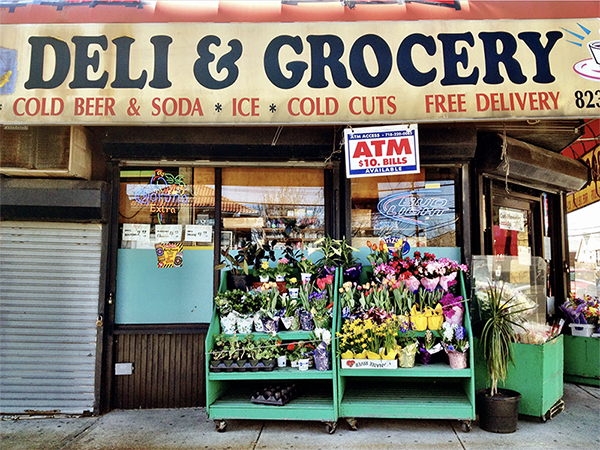
In the interest of reducing hospital visits and decreasing the prevalence of diet-related diseases, Montefiore’s community health department began to investigate ways to surround their hospitals with healthy eating options. The health system has undertaken a number of initiatives to increase access to healthy nutritious food for the community.
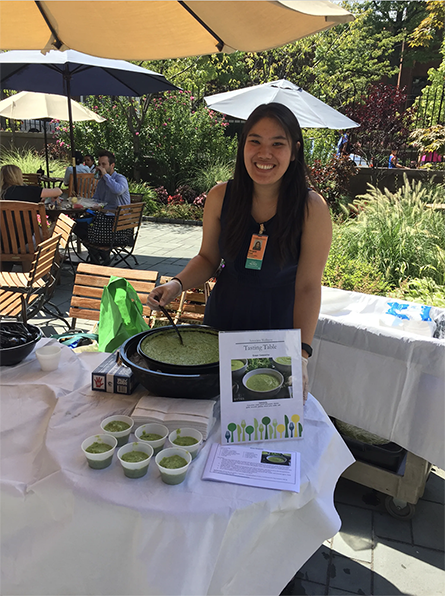
Montefiore hosts weekly farmers markets on four of their hospital campuses. The markets are stocked and run by the food service department. Each market features a cooking demonstration, with a meal comprised of ingredients available at the market. Eggplant and roasted cherry tomatoes proved popular this past summer, according to Nancy Deenihan-Gruber the Assistant Director of Food and Nutrition.
“You can taste the meal and go over to the market to buy the ingredients and go home and cook the meal that night,” she says.
The market sells the ingredients wholesale so there is no mark up and is working to incorporate Supplemental Nutrition Assistance Program (SNAP) and Women, Infants, and Children (WIC) payment options for patrons.
In addition to the farmers markets, Montefiore works with the New York Department of Health to host and support the Green Carts program. Green Carts are mobile food carts that sell whole fresh fruits and vegetables in target neighborhoods with low levels of fruit and vegetable consumption. The carts accept SNAP payments and sell produce at less expensive prices. Nearly all of Montefiore’s hospital campuses in the Bronx host Green Carts.
Working in conjunction with the New York City Healthier Hospitals Food Initiative, Montefiore is helping bodega owners to offer more fresh fruit, vegetables, and other healthy food products to their patrons. The program provides a financial incentive along with support and guidance to the bodegas.
In addition, Montefiore provides a resource center at a local food depot primarily utilized by these types of vendors. Over a dozen bodegas are currently participating in the program.
The results
For the dedicated staff at Montefiore “community health” extends beyond the Bronx and encapsulates the entire planet. Montefiore has taken tremendous strides toward making its food service facilities more sustainable such as composting food waste and even installing biodigesters at two facilities and is eager to measure the environmental impact of the health system’s purchasing choices and overall meat reduction.
“For everything we are prescribing to patients and doing,” said Hogan, there is a significant environmental impact. By choosing to offer a vegan diet, or vegetarian menu, there is a greater good you are serving, which is reducing carbon emissions.”
When considering what it means to grow and produce sustainable food, climate change may not be the first thing that comes to mind. Yet industrial agriculture is one of the biggest contributors of carbon emissions. The Intergovernmental Panel on Climate Change estimates that agriculture and associated land use changes are responsible for 24% of global emissions— greater than emissions from industry and greater than the combined emissions of transportation and buildings.
If food procurement remains entangled in industrial agriculture, this is in direct contradiction to health care’s healing mission. The health care sector can use its annual buying power of $12 billion (in the United States alone) to reduce the climate impact from agriculture by purchasing and serving foods that are protective of the climate.
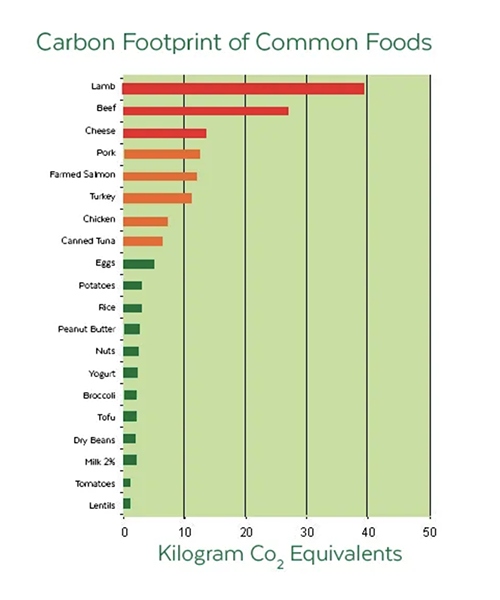
Reducing the amount of meat and cheese that is served is one of the most powerful measures food service departments can take to reduce climate impact. Livestock production contributes 18% of the world’s GHG emissions. Beef and cheese have the highest climate impact of all foods because cows consume more feed, and their digestive system produces more methane (a GHG 30 times more powerful than Carbon Dioxide [CO2]) than other livestock.
Montefiore has committed to reducing the amount of meat purchased and served at their facilities and to increasing their plant-centered menu options by signing onto the Cool Food Pledge. They have also utilized resources provided by Practice Greenhealth, Health Care Without Harm, and Montefiore’s food service distributor, US Foods, to track not only meat purchases but also which food ingredients are produced locally and sustainably. All of the chicken products purchased by the system, for example, are produced without the use of antibiotics for disease prevention or other routine purposes.
“If I knew the amount of meat we now purchase,” Hogan said, “I would know the cost savings and the environmental emissions. Just by having the one figure, it would provide me with additional selling points to further promote and expand the program”
Montefiore hasn’t had the opportunity to gather too much data as of yet due to the infancy of the plant-based diet program but is certain the impact will be significant. Data collected from one of their 11 facilities is showing a trend towards reduced meat purchasing and subsequent savings. This facility purchased 300 fewer cases of red meat in 2015 than in 2014. Montefiore also uses the Practice Greenhealth Awards to report on meat reduction and cost savings for several of their facilities. Benchmarking serves as a critical process for understanding health impacts.
About Montefiore Health System
Montefiore is one of New York’s premier academic health systems. It is comprised of 10 hospitals and more than 200 outpatient ambulatory care sites. Nationally recognized for its clinical excellence, Montefiore and its Albert Einstein College of Medicine represent the future of patient care, science, and education. Their commitment is simple: do more for every patient in every community we serve.
